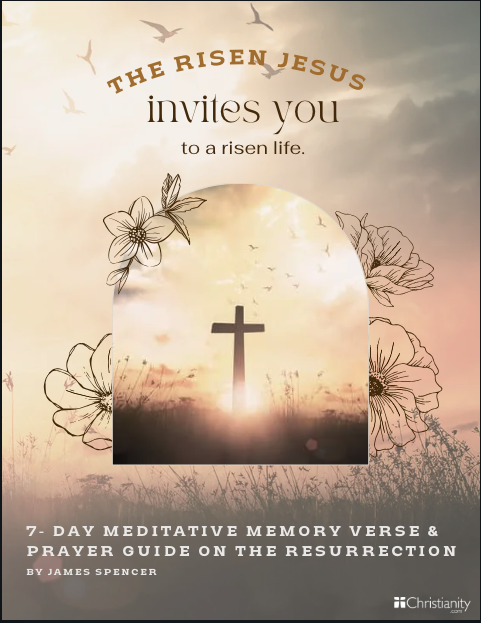The empty tomb is not the foundation of our faith. In other words, we don’t follow Jesus just because his tomb was empty, but because his life culminated in resurrection, ascension, and glorification. The grouping of the resurrection, ascension, and glorification distinguishes Jesus from others who were resurrected from the dead (e.g., 1 Kgs 17:17-24; 2 Kgs 4:18-37; 13:20-21; Matt 9:18-26; 27:52-53; Mk 5:21-43; Jn 11:1-44; Lk 7:11-17; 8:40-56; Acts 9:36-43; 20:7-12). Surely, there are other differences as well—no one else was, for instance, God incarnate (Phil 2:5-11)—but his ascension and glorification combined with his resurrection demonstrate the veracity of Christ’s life and teachings. He is “the way, the truth, and the life” (Jn 14:6) who calls us to deny ourselves, take up our cross, and follow him (Matt 16:24; Mk 8:34; Lk 9:23).
As we approach Easter, we approach a time of celebration, investigation, and often speculation. Christians celebrate the Easter season convinced of Jesus’ bodily resurrection from the dead. Scholars and journalists consider whether the “Jesus of history” could possibly square with the Christ of faith. Some, such as Adam Gopnik, lean on scholarship skeptical of the historical value of the gospels. Others, including Christian scholar Richard Bauckham, argue that the gospels are closely connected to and based upon eyewitness testimony, noting, “Throughout the lifetime of the eyewitnesses, Christians remained interested in and aware of the ways the eyewitnesses themselves told their stories. So, in imagining how the traditions reached the Gospel writers, not oral tradition but eyewitness testimony should be our principal model.”
There is good reason—as will be discussed below—to believe that the Bible is reliable, and that the crucifixion, resurrection, ascension, and glorification of Christ were historical events. Still, as we approach Easter, we need to recognize that the historical evidence for the resurrection—as important as it is—isn’t the best evidence for the resurrection. We are.
A Word about the Jesus of History and the Christ of Faith
In his essay titled “A Definition of the Concept of History,” Dutch historian Johann Huizinga observed that civilizations recount their past through distinct intellectual and cultural forms. He suggests, “History is the intellectual form in which a civilization renders account to itself of its past.” The “intellectual form” by which the society “renders” such an account may utilize a variety of methods, genres, and intellectual forms. Huizinga recognizes that not all accounts are equally trustworthy or valid; however, he does acknowledge that history tends to take on forms appropriate to the civilization.
We cannot say that the New Testament is exclusively historical. We can, however, recognize that the early Christian community was a civilization whose account of the past was rooted in the resurrection of Jesus Christ. For the New Testament authors, the “Jesus of History” and the “Christ of faith” are inseparable—they are one and the same. Having experienced Christ through in-person interactions (e.g., the disciples), visionary experiences (e.g., Paul), or the proclamation of the early church and testimony of the Holy Spirit, the world—past, present, and future—became Trinitarian.
To put it in Huizinga’s terms, the Christian community rendered account to itself of its past through a theological form. This theological form was not incompatible with other intellectual forms. We see evidence, for example, of some form of research in Luke’s gospel:
“Inasmuch as many have undertaken to compile an account of the things that have been accomplished among us, just as those who from the beginning were eyewitnesses and ministers of the word have delivered them to us, it seemed good to me also, having followed all things closely for some time past, to write an orderly account for you, most excellent Theophilus, that you may have certainly concerning the things you have been taught” (Lk 1:1-4; cf. Acts 1:1-5).
It isn’t that the theological form excluded intellectual form. Instead, the intellectual forms were nested within the theological form. The Christian community’s history was inseparable from this theological form. The church didn’t understand theology as an interpretive lens, but as a native language. In the church’s native tongue, any distinction between the Jesus of history and the Christ of faith would have been nonsensical.
Ancient Witnesses to the Resurrection
One of the earliest references to the resurrection comes in Paul’s first letter to the Corinthians, written around twenty years after the crucifixion, likely around AD 54 to 57. Paul recognizes the foundational nature of the resurrection noting, “If Christ has not been raised, then our preaching is in vain and your faith is in vain (1 Cor 15:14). He goes on to affirm, “But in fact Christ has been raised from the dead, the firstfruits of those who have fallen asleep. For as by a man came death, by a man has also come the resurrection of the dead. For as in Adam all die, so also in Christ shall all be made alive” (15:20-22). While there are still people alive who would have witnessed Christ’s crucifixion and seen him post-resurrection, Paul is bearing witness to the resurrection.
Paul identifies his preaching of the resurrection as what he has “also received” (15:3) before going on to express what seems to be an early Christian creed: “that Christ dies for our sins in accordance with the Scriptures, that he was buried, then he was raised on the third day in accordance with the Scriptures, and that he appeared to Cephas, then to the twelve” (15:3-5; cf. Lk 24:45-47). This creedal formula would have preceded Paul’s letter, reflecting the earliest of Christian convictions within living memory of Jesus’s death. Paul’s teachings are not of his own making but have been passed on to him as part of the Christian tradition. If this is the case, we see, beginning with the apostles, the proclamation of the bodily resurrection of Christ.
The Gospel accounts also offer relatively early attestation to the resurrection of Christ. Richard Bauckham challenges the widely held scholarly assumption that the gospel tradition was passed down through oral tradition and transmission. He suggests, “The Gospels were written within living memory of the events they recount.” He goes on to suggest, “We have been accustomed to working with models of oral tradition as it is passed down through the generations in traditional communities. We imagine the traditions passing through many minds and mouths before they reached the writers of the Gospels. But the period in question is actually that of a relatively (for that period) long lifetime.” Though they differ in many details, scholars such as Craig Blomberg and Craig Evans would affirm that the gospels were written within a time period sufficiently close to the historical events they depict to be reliable historical witnesses.
Modern-Day Witnesses to the Resurrection
While it is important to recognize the gospels and other biblical writings as reliable witnesses, Christians—all those united by faith in Jesus Christ—are the modern-day witnesses to the resurrection of Christ. Just as Jesus’s resurrection was unique, we are to offer a distinct testimony by following the way of Jesus. As we do so, we testify to his resurrection.
In Romans, Paul addresses our union with Christ. he notes that all those who have been “baptized into Christ Jesus were baptized into his death” (Rom 6:3). Baptism signified a radical commitment to Christ. Through baptism, one was placed in the grave with Christ—buried with him (6:4). Being buried with Christ was necessary to achieve a particular purpose: “in order that, just as Christ was raised from the dead by the glory of the Father, we too might walk in newness of life” (6:4). Baptism is the means by which we identify with Christ in his death—a death to the way of life we’d lived before that would allow us to “walk in newness of life.”
The “newness of life” is compared to Christ’s resurrection (“…just as Christ was raised from the dead by the glory of the Father, we too might walk in newness of life”). Our union with Christ in his death yields an opportunity for us to live according to the pattern of Christ. Being buried with Christ through baptism was part of what New Testament scholar James D. G. Dunn refers to as the “conversion-initiation” experience. For Paul and the early Christian community, Baptism was not simply a profession of faith, but an initiation into a cruciform way of life. Walking “in newness of life” was a demonstration of one’s conversion and initiation into the way of Jesus.
We see a similar connection in the first letter to the Corinthians. Paul draws a comparison between the people of Israel and the Christian community by utilizing the language of Christian baptism: “For I do not want you to be unaware, brothers, that our fathers were all under the cloud, and all passed through the sea, and all were baptized into Moses in the cloud and in the sea” (1 Cor 10:1-2). He goes on to note that despite this common baptism and the provision of God for all (10:3-4), they displeased and “were overthrown in the wilderness” (10:5). This example was given to the Christian community “that we might not desire evil as they did” (10:6; cf. 10:11).
Though Paul focuses on the bread and cup of the Lord’s supper later in the verse, the reference to the baptism of Moses fits the pattern of Romans 6. Those who were delivered by God through Moses at the Exodus and given sustenance by God in the wilderness refused to change their ways. Despite God’s deliverance and provision for Israel, the Israelites refused to set aside their former ways. Paul warns the members of the new covenant community not to repeat that pattern. Grace and salvation were to yield a transformed life.
In any case, it seems clear that walking in “newness of life” is reflective of our burial with Christ in baptism. Our lives, to the extent that we walk in newness of life, testify to the resurrection. Christ’s death and burial led to a resurrection on the third day. Our burial with Christ in the “conversion-initiation” event of baptism is to lead to a distinctive way of living in the world. As Paul goes on to say, “Do not present your members to sin as instruments for unrighteousness but present yourselves to God as those who have been brought from death to life, and you members to God as instruments of righteousness” (Rom 6:13).
Greeting one another with “He is risen! He is risen, indeed!” on Easter is a liturgical practice that should push us toward transformation. When our lives bear the shape of Christ’s resurrection, we become what the empty tomb alone could never be: living, breathing evidence of the living Christ. So, this Easter, let us proclaim “He is risen, indeed!” But let us also proclaim the resurrection beyond Easter through words and deeds that recognize the victory we have over sin and death through our Lord and Savior Jesus Christ.
7-Day Meditative Memory Verse and Prayer Guide on the Resurrection
Day 1 – The Resurrection Foretold
“He is not here, but has risen. Remember how he told you, while he was still in Galilee, that the Son of Man must be delivered into the hands of sinful men and be crucified and on the third day rise.” - Luke 24:6-7
Heavenly Father,
As I await the final resurrection, help me to live now as someone already made alive in Christ.
Amen.
Day 2 – The Resurrection Declared
“But if there is no resurrection of the dead, then not even Christ has been raised. And if Christ has not been raised, then our preaching is in vain and your faith is in vain...But in fact Christ has been raised from the dead, the firstfruits of those who have fallen asleep.” -1 Corinthians 15:13-4, 20
Lord,
Help me grasp the depths of the significance of your resurrection. May I look to you as the one who, through your sacrificial work on the cross, allows me to overcome sin and death that I might share in your resurrection.
Amen.
Day 3 – Newness of Life
“We were buried therefore with him by baptism into death… so that we too might walk in newness of life.” -Romans 6:4
Risen Lord,
Remind me today of my union with you through baptism into death and help me to walk in the newness of life you have secured.
Amen.
Day 4 – A Living Hope
“According to his great mercy, he has caused us to be born again to a living hope through the resurrection of Jesus Christ from the dead.” -1 Peter 1:3
Jesus,
Your resurrection is not just history but hope. Breathe that hope into my heart afresh today that I may point to and glorify you with all I am and have.
Amen.
Day 5 – The Guarantee of Eternal Life
“I am the resurrection and the life. Whoever believes in me, though he die, yet shall he live…” -John 11:25-26
Lord,
Keep me from settling for old ways. Lead me into resurrection living—transformed and holy as I follow you to a life spent in the presence and glory of God.
Amen.
Day 6 – The Victory of Resurrection
“We know that Christ, being raised from the dead, will never die again; death no longer has dominion over him.” -Romans 6:9
Father,
Thank you for the power that raised Jesus from the dead. May that same power reshape my life today.
Amen.
Day 7 – Our Resurrection Future
“That I may know him and the power of his resurrection… that by any means possible I may attain the resurrection from the dead.” - Philippians 3:10-11
Christ,
As you walked out of the tomb, teach me to walk out of fear, shame, and sin, and into the life of peace that surpasses all understanding.
Amen.
Click Here to Download the 7-Day Meditative Memory Verse and Prayer Guide on the Resurrection
Photo Credit: SWN Design






